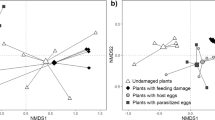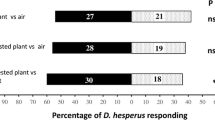Abstract
Responses of individual females of the parasitoidCotesia marginiventris to the odors of four different complexes of host larvae feeding on leaves were observed in a four-arm olfactometer. The plant-host complexes were composed of fall armyworm (FAW) larvae or cabbage looper (CL) larvae feeding on either corn or cotton seedlings. Prior to testing, each female was given a brief foraging experience on a plant-host complex and was then exposed to the odors of the same complex in the olfactometer. The experienced females responded to familiar odors in a dose-related manner, and these responses were virtually identical to all four complexes. Preferences for the odors of one of two plant-host complexes were tested in dual choice situations. Generally, FAW odors were preferred over CL odors and corn odors over cotton odors. A short foraging experience significantly affected the females' odor preferences in favor of the odors released by the experienced complex. Additional experiments revealed that neither longer bouts of experience nor bouts that included ovipositions resulted in a stronger change in preference. Experience affected preference in combinations where only the host species was varied as well as in combinations where only the plant species was varied. The results, therefore, strongly indicate that both the plants and the hosts somehow are involved in the production and/or release of the semiochemicals that attractC. marginiventris.
Similar content being viewed by others
References
Alphen, J.J.M. van, andVet, L.E.M. 1986. An evolutionary approach to host finding and selection, pp. 23–61,in J.K. Waage and D.J. Greathead (eds.). Insect Parasitoids. Academic Press, London.
Arthur, A.P. 1971. Associative learning byNemeritis canescens (Hymenoptera: Ichneumonidae).Can. Entomol. 103:1137–1141.
Ashley, T.R. 1986. Geographical distribution and parasitization levels for parasitoids of the fall armyworm,Spodoptera frugiperda.Fla. Entomol. 69:516–524.
Dmoch, J., Lewis, W.J. Martin, P.B., andNordlund, D.A. 1985. Role of the host-produced stimuli and learning in host selection behavior ofCotesia (=Apanteles)marginiventris (Cresson).J. Chem. Ecol. 11:453–463.
Drost, Y.C., Lewis, W.J., Zanen, P.O., andKeller, M.A. 1986. Beneficial arthropod behavior mediated by airborne semiochemicals. I. Flight behavior and influence of preflight handling ofMicroplitis croceipes (Cresson).J. Chem. Ecol. 12:1247–1262.
Eller, F.J., Tumlinson, J.H., andLewis, W.J. 1988. Beneficial arthropod behavior mediated by airborne semiochemicals. II. Olfactometric studies of host-location by the parasitoidMicroplitis croceipes (Cresson) (Hymenoptera: Braconidae).J. Chem. Ecol. 14:425–434.
King, E.G., andLeppla, N.C. 1981. Advances and Challenges in Insect Rearing. Agric. Res. Serv., USDA, U.S. Government Printing Office, Washington, D.C.
Lewis, W.J., andBurton, R.L. 1970. RearingMicroplitis in the laboratory withHeliothis zea as hosts.J. Econ. Entomol. 63:656–658.
Lewis, W.J., andNordlund, D.A. 1985. Behavior-modifying chemicals to enhance natural enemy effectiveness, pp. 89–101,in M.A. Hoy and D.C. Herzog (eds.). Biological Control in Agricultural IPM Systems. Academic Press, New York.
Lewis, W.J., andTumlinson, J.H. 1988. Host detection by chemically mediated associative learning in a parasitic wasp.Nature 331:257–259.
Monteith, L.G. 1963. Habituation and associative learning inDrino bohemica Mesn. (Diptera: Tachinidae).Can. Entomol. 95:418–426.
Sandlan, K. 1980. Host location byCoccygomimus turionellae (Hymenoptera: Ichneumonidae).Entomol. Exp. Appl. 27:233–245.
Sas Institute 1987. SAS/STAT Guide for Personal Computers, Version 6 Edition. SAS Institute, Inc., Cary, North Carolina. 1028 pp.
Strand, M.R., andVinson, S.B. 1982. Behavioral response of the parasitoidCardiochiles nigriceps to a kairomone.Entomol. Exp. Appl. 31:309–315.
Taylor, R.J. 1974. Role of learning in insect parasitism.Ecol. Monogr. 44:89–104.
Thorpe, W.H. andJones, F.G.W. 1937. Olfactory conditioning and its relation to the problem of host selection.Proc. R. Soc. London, Ser. B 134:56–81.
Turlings, T.C.J., Tumlinson, J.H., Lewis, W.J., andVet, L.E.M. 1989. Beneficial arthropod behavior mediated by airborne semiochemicals. VIII Learning of host-related odors induced by a brief contact experience with host by-products inCotesia marginiventris, a generalist larval parasitoid.J. Insect Behav. 2:217–225.
Vet, L.E.M. 1983. Host-habitat location through olfactory cues byLeptopilina clavipes (Hartig) (Hym.: Eucoilidae), a parasitoid of fungivorousDrosophila: The influence of conditioning.Neth. J. Zool. 33:225–248.
Vet, L.E.M. 1988. The influence of learning on habitat location and acceptance by parasitoids,In. Proceedings of the Third European Workshop on Insect Parasitoids.Colloq. INRA 48:29–34.
Vet, L.E.M., andVan Opzeeland, K. 1984. The influence of conditioning on olfactory micro-habitat and host location inAsobara tabida (Ness) andA. rufescens (Foerster) (Braconidae: Alysiinae), larval parasitoids of Drosophilidae.Oecologia 63:171–177.
Vet, L.E.M., andVan Opzeeland, K. 1985. Olfactory microhabitat selection inLeptopilina heterotoma (Thomson) (Hym.: Eucoilidae), a parasitoid of Drosophilidae.Neth. J. Zool. 35:497–504.
Vet, L.E.M., Van Lenteren, J.C., Heijmans, M., andMeelis, E. 1983. An airflow olfactometer for measuring olfactory responses of hymenopterous parasitoids and other small insects.Physiol. Entomol. 8:97–106.
Vinson, S.B. 1976. Host selection by insect parasitoids.Annu. Rev. Entomol. 21:109–133.
Vinson, S.B., 1981. Habitat location, pp. 51–77,in D.A. Nordlund, R.L. Jones, and W.J. Lewis, (eds.). Semiochemicals: Their Role in Pest Control. John Wiley & Sons, New York.
Vinson, S.B. 1984. Parasitoid-host relationship, pp. 205–233,in W.J. Bell and R.T. Cardé (eds.). Chemical Ecology of Insects. Sinauer Associates Inc., Massachusetts.
Vinson, S.B., Barfield, C.S., andHenson, R.D. 1977. Oviposition behaviour ofBracon mellitor, a parasitoid of the boll weevil (Anthonomus grandis). II. Associative learning.Physiol. Entomol. 2:157–164.
Wardle, A.R., andBorden, J.H. 1985. Age-dependent associative learning byExeristes roborator (F.) (Hymenoptera: Ichneumonidae).Can. Entomol. 117:605–616.
Weseloh, R.M. 1981. Host location by parasitoids, pp. 79–95,in D.A. Nordlund, R.L. Jones, and W.J. Lewis, (eds.). Semiochemicals: Their Role in Pest Control. John Wiley & Sons, New York.
Author information
Authors and Affiliations
Additional information
Mention of a proprietary product does not constitute an endorsement or the recommendation for its use by the USDA.
Rights and permissions
About this article
Cite this article
Turlings, T.C.J., Scheepmaker, J.W.A., Vet, L.E.M. et al. How contact foraging experiences affect preferences for host-related odors in the larval parasitoidCotesia marginiventris (Cresson) (Hymenoptera: Braconidae). J Chem Ecol 16, 1577–1589 (1990). https://doi.org/10.1007/BF01014091
Received:
Accepted:
Issue Date:
DOI: https://doi.org/10.1007/BF01014091




